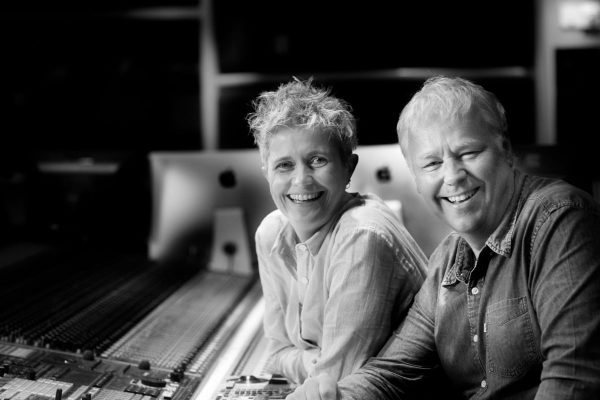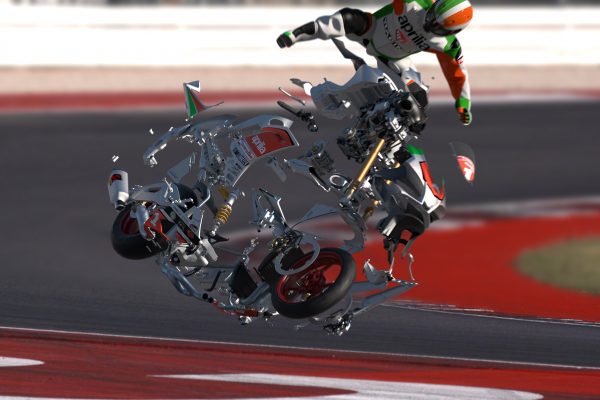The death of 27-yr old Sarah Jones, who was hit by a freight train last year on the set of the Gregg Allman biopic Midnight Rider, was a serious wake-up call to the film industry. After an initial plea of ‘not guilty’, today the film’s director Randall Miller, changed his plea to ‘guilty of criminal trespass and involuntary manslaughter’.
In an historic first for the USA, Miller was sentenced in a Wayne County court room, to a 2-year jail term.
By Nicole Boyd
In the last 100 years since the first deaths occurred on a film set, during principal photography on the 1914 film Across the Border, over 80 people have died on film sets in the US alone. World figures are unknown, but at the time of writing includes the mid-air collision of helicopters earlier today, in Argentina during filming of a French reality television show.
What is exceedingly rare, however, is the prosecution of film directors and producers in relation to the deaths of cast and crew whilst filming.
The last time any director was held accountable (in the USA) was over 30 years ago in 1982, when a helicopter crashed on the set of Twilight Zone: The Movie, killing actor Vic Morrow and child-actors Myca Dinh Le and Renee Shin-Yi Chen. After many years of civil and criminal court cases, the film’s director John Landis and his co-defendants were acquitted of any wrongdoing in the tragedy.
The case prior to that, was way back in 1929, when ten people were killed in a fire at Manhattan’s Pathé Film Studio and charges of second-degree manslaughter were brought against (then later dismissed) Harry Lalley (production manager) and John C. Flinn (studio vice president).
*EDIT* One of our readers Roger Simonsz has pointed out that during the filming of the French film, Taxi 2 (2000) a cameraman was killed when a Peugeot 406 slammed into the crew after a stunt went awry. The film’s writer/producer Luc Besson, director Gérard Krawczyk, and stunt coordinator Rémy Julienne were all charged with involuntary manslaughter. Initially, a court cleared all charges against Besson and Krawczyk, with 77-yr old Julienne receiving a suspended 18-month jail sentence. But a 2009 court of appeal found that Eurocorp (Besson’s production company) had been negligent by not allowing Julienne a test run of the stunt (before the accident) in a bid to save money, fining the company €100,000. Julienne received a 6-month reduction to his sentence and was ordered to pay the family of the cameraman €50,000 (source). Currently, the case is still under appeals in the French courts.
It just goes to show that skipping over important safety measures, is not isolated to the US alone, it can happen and does happen, the world over. In the history of Hollywood, however, this is the first time that a film’s director has received a felony conviction and will serve actual jail time for the death of a crew member.
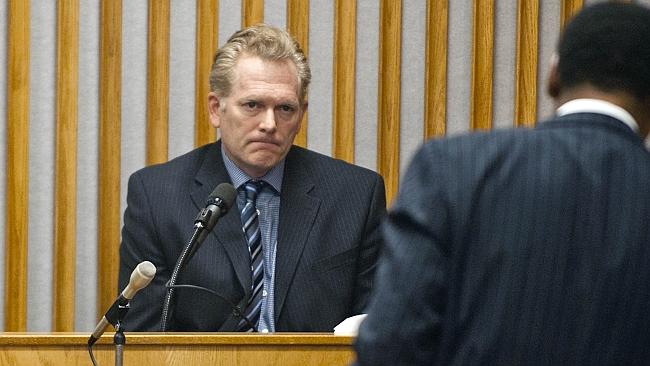
Randall Miller takes the stand, during his trial in the death of Sarah Jones (Image: AP).
The accident occurred on February 20th, 2014, while Sarah Jones, who was working as a camera assist on the film, was shooting a scene with cast & crew that took place on the train trestle. Believing that it was safe, the crew assembled a bed on the tracks and had been told, incorrectly, that no more train’s were due to cross the trestle.
At the time, William Hurt (lead actor) wrote in an email to a friend, that he had asked producers, “how long the crew had to get off if by some impossible chance another train came” and was told 60 seconds. I said, ‘Sixty seconds is not enough time to get us off this bridge.’ There was a communal pause. No one backed me up. Then, we ….. Just went ahead. I took off my shoes, got on the heavy, metal hospital bed and began preparing.”
“We didn’t have sixty seconds. We had less than thirty” (source).
Hurt later resigned from the film and filming hasn’t resumed. In fact, it likely won’t resume for at least 10-years (if ever) under the terms of Miller’s sentence. Added to that is the face Gregg Allman sued Miller last year to prevent the director from continuing the film. The case settled out of court, the terms of which were not disclosed to the public.
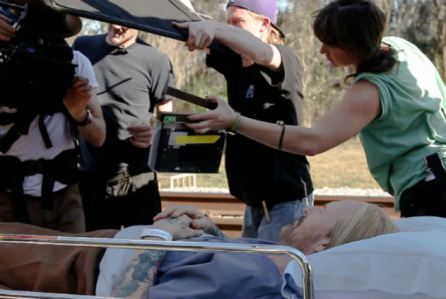
Sarah Jones on set with William Hurt before tragedy struck
(image: ABC News).
Today, Miller was sentenced to a jail term of 2-years, with a further 8-years probation – the terms of which prevent him from working as a director or assistant director – and disallows him from overseeing the safety of others, in any capacity. He also received a $20,000 fine and 360-hours of community service.
Insisting that Miller believed the shoot to be safe, his lawyer Ed Garland, told the waiting media that he expected his client would serve only twelve months in jail.
“He had been told that no other trains would be coming. He believed it was a safe track. He was also under the impression that it was alright” to use the trestle whilst shooting. Reiterating that his client “never had a single significant accident” on the set of one of his films, despite “a lot of false information in the media”.
Other’s prosecuted in the case was Midnight Rider executive producer and unit production manager Jay Sedrish, along with Miller’s wife, producer Jody Savin and 1st AD Hillary Schwartz. As part of Miller’s plea deal, all charges to his wife Savin were dropped.
Sedrish also entered a plea deal and received a $10,000 fine with a 10-year probation under the same terms as Miller. Sedrish’s attorney, John Ossick, told the court, “Without concession or admission of guilt, we agree there’s a substantial factual basis that exists for the court to accept the plea and establish guilt.”
Schwartz’s court proceedings are still on-going (UPDATED below).
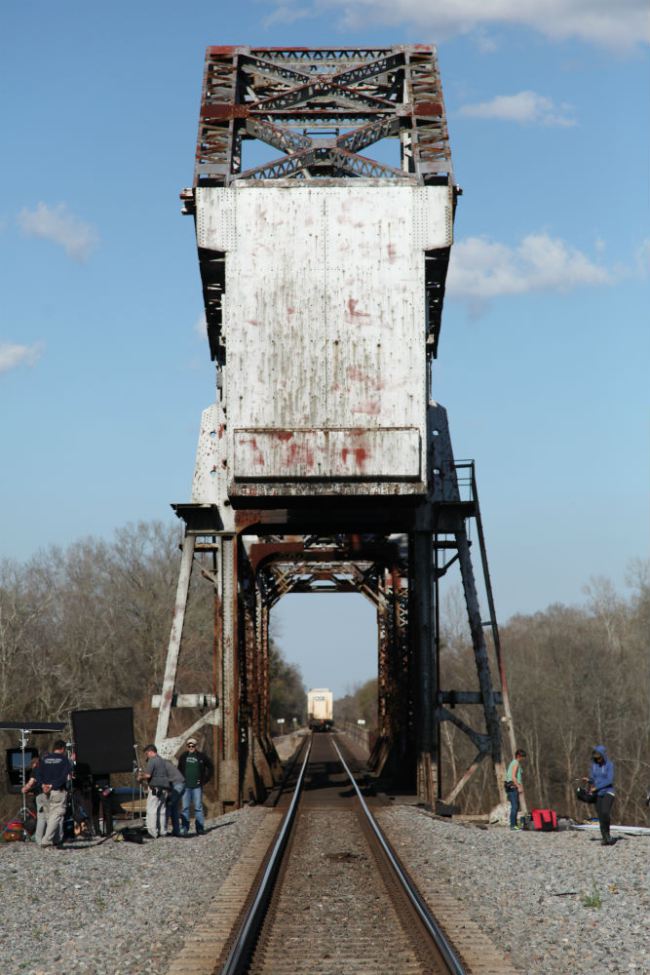
The trestle bridge set of ‘Midnight Rider’ (image: ABC News).
The case for the filmmakers began to fall apart last October, when lawyers representing Miller and his wife Savin, released a statement to ABC News saying the pair “believed there was no danger present in filming on the tracks that day because they believed they had permission to be on the tracks from Rayonier and CSX.”
Further, the pair said that representatives of the landowner, Rayonier, informed them that only two trains would pass through the trestle that day and after watching two trains go by, they believed it was safe to begin shooting.
However, this was refuted by Rayonier, in papers filed during a civil case brought against the producers, by the parents of Sarah. The company stated that whilst it did give producers access to the trestle, its representatives did not give the pair any information regarding the CSX train schedule, that the pair (Miller and Savin) were aware of the dangers and had informed them to request permission to film directly to CSX.
Also stating that the producer’s “planned to film a scene on active railroad tracks despite their knowledge of the danger presented by filming a scene on active railroad tracks” (you can read those court papers, here).
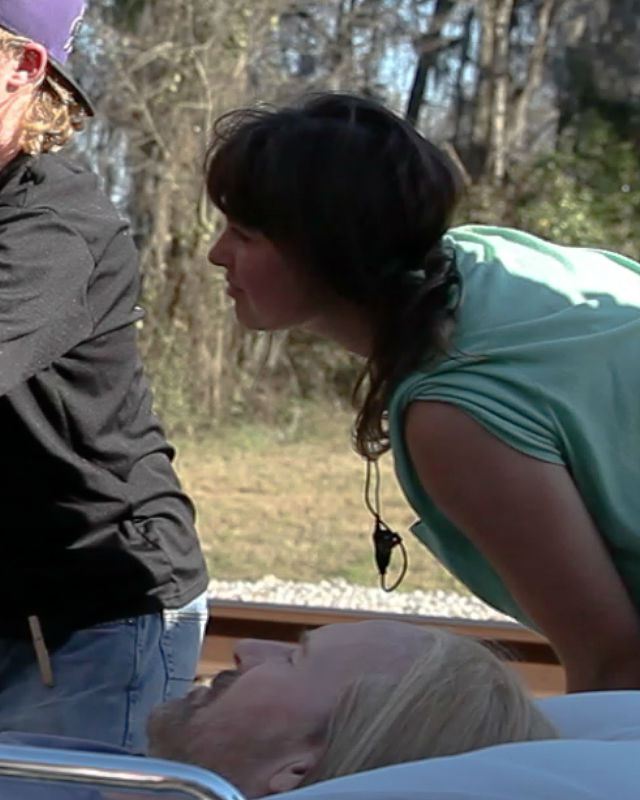
Sarah Jones on set with William Hurt before tragedy struck (image: ABC News).
Papers filed (in the civil case) by Midnight Rider‘s location manager, Charles Baxter (who wasn’t present when filming was taking place on the trestles) revealed that he was “unable to obtain permission from CSX to conduct filming on the trestle bridge” and that he “denies that he planned to film a scene on active railroad tracks” (you can read Baxter’s papers, here).
A 182-page investigative report (that you can read here) by the US Dept. of Labor Occupational Safety and Health Administration (OSHA) found that the producers and director were informed three times that permission was not granted by CSX and that this information was not shared with the rest of the cast and crew of Midnight Rider.
It also found that no safety inspections or tech scouts had taken place on the trestle, with Miller stating to investigators that “It was probably a financial reason we didn’t go there.” However, Sedrish stated that a tech scout was not needed due to the fact “they were not going to be bringing any generators or any major equipment to the site.”
The report also stated that non-compliance with OSHA’s safety standards meant that “the company was able to save money and time by not transporting the dept. heads and lead workers to visit the film site and discuss safety issues, during a Technical Scout” and that the company was also able to save money “by stealing the shot” (source).
After sentencing Miller and Sedrish, Judge Anthony Harrison said, “there is nothing this court could do to really bring justice to this case. This is a tragic accident … that could have been prevented.”
Speaking directly to Sarah’s parents, he said, “I hope that this day will contribute to your goal of sending a message of safety to the industry … and give some meaning to this tragedy.”
As Steven Spielberg said when discussing the helicopter crash during filming of Twilight Zone: The Movie (in Joseph McBride’s biography):
“No movie is worth dying for. I think people are standing up much more now than ever before to producers and directors who ask too much. If something isn’t safe, it’s the right and responsibility of every actor or crew member to yell, ‘Cut!’
We agree and We Are All Sarah.
*UPDATE*
First AD Hillary Schwartz was sentenced today (March 11, 2015) to 10-years probation under similar terms as Miller and Sedrish, the only difference being is that she can act as a producer on projects, so long as it doesn’t involve overseeing the safety of others. She was also slapped with a $5000 fine.
Sarah’s Father Richard Jones said to the court that Schwartz’s role as assistant director meant she had a responsibility to ensure that the set was safe at all time, and that she “apparently failed in her duty to do so.”
Last month, Schwartz attempted to have her case thrown out, claiming prosecutorial misconduct. She told the court that she had believed an interview she had with investigators was done under the protection of immunity.
There are several civil cases pending against the filmmakers that involve injuries to crew members from the accident. The civil case brought by Sarah’s parents for wrongful death against Miller and the production team reached a settlement last year, with undisclosed terms.
At that time, the Jones’s attorney Jeff Harris said to the media:
“Richard and Elizabeth Jones’ objectives in filing this lawsuit, after the death of their 27-year-old daughter, Sarah, have been clear and unwavering,” said Harris.
“To find out what happened on the day of their daughter’s death, determine who was responsible, hold those who made bad decisions accountable and ensure this kind of tragedy never happens again on another film set. Today, we are another step closer to fully achieving those objectives.”
*UPDATE 2*
Randall Miller has finally released a statement regarding the death of Sarah, which (according to Nick Carr, from Scouting New York) is “absolutely grotesque”.
On the 19th March, 2015 Miller released the statement to the media, which reads:
“On Feb 20th, 2014, a great number of mistakes were made and the terrible accident occurred which took Sarah Jones’ life. It was a horrible tragedy that will haunt me forever. Although I relied on my team, it is ultimately my responsibility and was my decision to shoot the scripted scene that caused this tragedy.
I pleaded guilty for three reasons: first, to protect my wife and family; second, out of respect for the Jones family and to not put them through a difficult trial; and, third, to take responsibility for my failure in not knowing that every safety measure was in place.
The location manager, the production designer, the unit production manager, the cinematographer, assistant director and others all made mistakes that led to this, but I have taken responsibility because I could have asked more questions, and I was the one in charge. I have worked in the film industry as a director for 25 years and never had a significant accident of any kind on any one of my sets.
I am heartbroken over this. I hope my actions have spared the Jones family more anguish and that the on-set safety measures that were lacking before this terrible tragedy will now take precedence for all in the industry.”
It’s defensive and self-righteous tone left Carr incensed, saying:
“When you work on a movie, there is intense pressure to provide everything the director asks for. You’re there for one purpose, to help realize the director’s vision, and if you can’t do it, you should get out of the way for the folks who can.
In other words, the worst thing you can say to a director is “no.”
For the most part, the shoots I’ve worked on in my career have been conducted safely and professionally. But I’ve certainly run into my share of directors like Randall Miller – guys who are willing to put their crew at unnecessary risk, say, by demanding a street be closed without police permission, or attempting to forgo a safety test for an abandoned location knowing there’s a good chance it’ll come back positive for asbestos and other hazards. I once nearly got in a fist fight trying to stop a crew member from literally cutting down a stop sign that the director felt was out of place in his shot.
The blowback you get from denying requests like these can be unbelievable. “Come on, can’t we get away with it?” “No one’s going to get hurt.” “It’ll just take five seconds.” “Well, why didn’t you anticipate the director would ask for this in prep?”
And that is a very true statement. Crew members trust that all measures have been put in place to ensure the safety of the equipment, if not themselves.
Carr broke down the statement, reading between-the-lines (his emphasis included):
“Although I relied on my team [my crew was unreliable, and let me down], it is ultimately my responsibility and was my decision to shoot the scripted scene that caused this tragedy.”
“I pleaded guilty for three reasons: first, to protect my wife and family…” [above all else, the reason I pleaded guilty was to get the charges dropped against my wife]
“Second, out of respect for the Jones family and to not put them through a difficult trial…” [I’m only pleading guilty because proclaiming my rightful innocence would cause too much grief for the Jones family]
“And, third, to take responsibility for my failure in not knowing that every safety measure was in place.” [Why is this third? Why isn’t this first? Why are there even any other bullet points to this?]
“The location manager, the production designer, the unit production manager, the cinematographer, assistant director and others all made mistakes that led to this…” [Literally, everyone on my crew is in some way responsible for the tragedy. Everyone except the producer, who happens to be my wife.]
“But I have taken responsibility because I could have asked more questions, and I was the one in charge.” [I am only guilty of being misinformed. Had I been better informed by my crew that filming on a train trestle that we had been expressly denied permission to enter is fucking dangerous, this tragedy could have been avoided.]
“I have worked in the film industry as a director for 25 years and never had a significant accident of any kind on any one of my sets.” [My unblemished record is further proof of my innocence.]
“I am heartbroken over this. I hope my actions have spared the Jones family more anguish…” [Please acknowledge my sacrifice in pleading guilty when I do not believe it to be the case]
“…and that the on-set safety measures that were lacking before this terrible tragedy will now take precedence for all in the industry.” [Had proper film safety measures been more securely in place, I would have never been allowed to do what I did.]
Carr doesn’t mince his words. But we’re inclined to agree with him, it’s reprehensible to blame others for what is ultimately your responsibility.
We hope that by some measure Sarah’s parents have found some peace with the knowledge that, in future, film crews might just speak up when asked to put themselves in danger. And that directors/producers will make crew safety a high priority. Because the risks they take with their crews, is also a risk to their careers, and may just win them jail time, if precautions aren’t taken and tragedy occurs.
For more information, read our piece written at the time of the accident: How the Death of Sarah Jones has Changed Filmmaking.

Oscar’s tribute to Sarah Jones
Sources: The Hollywood Reporter, Deadline Hollywood and the New York Times.


